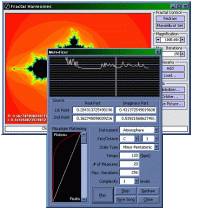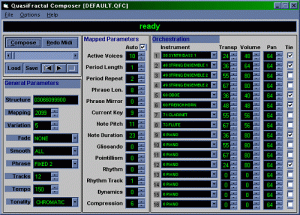Software in this category are no longer available (at least I couldn’t find them) or don’t run on Windows 10. If you have a computer running an older Windows flavor (pre-Windows 7), you may be able to use them… granted that you find them first. The following notes were written more than ten years ago, so they are as old as the software they describe. Do not take them as current and valid, except when they indicate the program no longer runs in Windows or is no longer available.
 Cellular Automata Music Generator (CAMUS) ~ v2.0
Cellular Automata Music Generator (CAMUS) ~ v2.0
OS: Win9x/Me
author: Glasgow University Centre for Music Technology, Tim Conrardy.
url: http://tamw.atari-users.net
CAMUS is based on a program originally created by Eduardo Reck Miranda in 1991 for the Atari computer. This Win9x version employs the cellular automata algorithm to generate musical notes using two parallel windows: the Game of Life, and the Demon Cyclic Space. The software is no longer available (Mr. Conrardy, its maintainer, passed away in 2009). An Atari computer version is available in the url.
Last revision: 1997.
 Fractal Harmonies ~ v1.1
Fractal Harmonies ~ v1.1
OS: Win9x/Me/NT/2000
author: Stefanie Blain and Jason Montojo
url: n/a
Fractal Harmonies combines image creation with music composition in a very easy way. It can compose musical tunes from Mandelbrot and Julia set fractals. It comes with several tools and options to control your compositions. Both the melody and the image can be saved. It seems it’s no longer available.
Last revision: 15 March 2000.
 Fractal Music ~ v1.9
Fractal Music ~ v1.9
OS: Win9x/Me
author: David H. Singer
url: n/a
The Fractal Music combines Lindenmayer System fractals with Cellular Automata to compose 5-voice fractal music. You can select note durational patterns, scales and subset of the scale, and control how CA cell-state changes map to MIDI events. I haven’t tested it in Windows 10 yet.
Last revision: 2000.
 Gingerbread ~ v2.0/3.0
Gingerbread ~ v2.0/3.0
OS: Win9x/Me/NT/XP/Vista
author: Phil Thompson
url: n/a
Once again, Phil is offering his old fractal music software collection “as is”: he will no longer give support, so users will download, install and use at their own risk. Available are two versions of Gingerbread (2.0 and 3.0). According to many fractal music experts, Gingerbread is one of the most (if not the most) powerful fractal music generation software ever created. Version 2.0 requires a freely available registration code (visit Phil’s web site, fractalmusician.com, to get it), while version 3.0 requires no registration at all. NOTE: Those were my original notes, current until 2006. Right now, only Gingerbread 2.0 is still available (use this url). Alas, it’s not compatible with Window 10.
Last revision: 2002.
LMUSe ~ v0.7b
OS: DOS/JAVA
author: David Sharp
url: http://www.oocities.org
LMUSe will convert L System fractals into musical compositions. Both images (GIF) and sound (MID or parameters) can be save. It is designed for DOS, but will run on Windows 9x without any problem. Actually, it’s one of the most user-friendly DOS programs I’ve seen. There’s also a new Java version on its web site, with some improvements. This last one requires the Java 1.3 JRE (or later) installed on your system (available separately from www.sun.com or some other jave-enable software).
Last revision: 24 December 1998 / 22 June 2001.
 Make Prime Music 98 ~ v1.1.3.2b
Make Prime Music 98 ~ v1.1.3.2b
OS: DOS
author: Armand Turpel
url: n/a
This program creates midi files from prime numbers. Just input a prime number and a new MIDI file will be automatically created and saved to your hard disk or wherever you installed the program. You can change some parameter values (tempo, volume, size, note range, method, instruments and some more) modifying the mpmusic.ini file. Run in a windowed DOS session.
Last revision: 1998.
 Mandelbrot Music Program
Mandelbrot Music Program
OS: Win9x/Me/NT
author: Yo Kubota
url: n/a
Explore the Mandelbrot set while the iteration values are transformed into music by a composition rule. MIDI files and their corresponding ini files (where parameter values are stored) are automatically saved every time you compose a new melody. 16-bit and 32-bit versions available.
Last revision: 22 February 1999.
 MusiNum ~ v2.08b
MusiNum ~ v2.08b
OS: Win3.x/9x/Me/NT/Vista
author: Lars Kindermann
url: http://reglos.de
MusiNum turns integer numbers into musical notes (including chaos, fractals and self-similarity concepts). Each voice channel is presented in a different window, making it easier for beginners to work with all available options and instruments. This new version adds better script capabilities, more midi devices, and file association. Great program.
Last revision: 19 October 1999.
 Project Oblivion ~ v1.27a
Project Oblivion ~ v1.27a
OS: Win9x/Me
author: Tom
url: n/a
Oblivion uses various random number algorithms and attempts to pull from a collection of random numbers musical sounds to make its compositions. The resulting files can be saved as MIDI and .obv format. You can also modify several options available directly from the main screen.
Last revision: 25 March 1999.
 Quasi Fractal Composer ~ v2.01
Quasi Fractal Composer ~ v2.01
OS: Win9x/Me/Vista
author: Paul Whalley
url: http://members.tripod.com
This is another interesting algorithmic music generator full of surprises. It is similar to MusiNum, but with one single interface. It has several saving options (for midi, scale, orchestration and composition).
Last revision: 28 May 1999.
Venharis ~ v1.0
OS: Win98/Me/WinXP
author: Phil Thompson
url: n/a
Combining a gaming interface with a powerful fractal music generator, expect the unexpected with this software, since its interface is very unique. It’s not plain software; it’s an interactive experience that would let you create some fractal compositions while you experiment with it. Requires a 3D video card and DirectX 7.0 or later.
Last revision: November 2002.
Well-Tempered Fractals ~ v3.0
OS: DOS
author: Robert Greenhouse
url: http://www.hiddendimension.com
This program composes musical melodies by mapping fractal images to musical scales. Ten different fractal types, including Julia, Hopalon, KAM Torus, Chevychev, Ikeda and Mira, may be mapped to twenty-one different musical scales. Twenty symmetry operators may be applied to the image as it is plotted. The output may be directly heard or written to a MIDI file. Runs quite well in Win9x (DOS full screen). Alternate site.
Last revision: 17 July 1995.